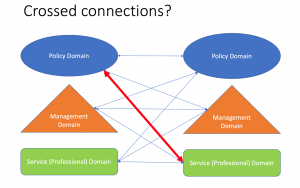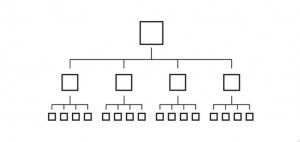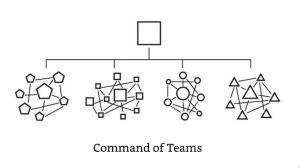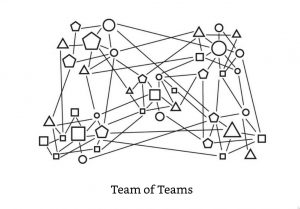This ‘think piece’ builds on my recent presentation to a seminar for senior officials hosted by the Wales Centre for Public Policy which looked at the thorny issue of cross-government working. It isn’t an academic review, and I have deliberately not burdened it with lots of academic references. Instead I’m drawing on practical, interesting and inspiring ideas that I have come across in my many years of engagement with public services, in the UK and internationally.
A theoretical framework that I have found particularly useful is domain theory (see below). It highlights differences between the ‘policy domain’, ‘management domain’ and ‘service domain’ – in values and in ways of working. This matters to discussions about cross-government working because many of the big ‘wicked issues’ lie in the arena of the service/professional domain. Areas like social protection, education and health account for around two-thirds of spending, and a similar proportion of the public sector workforce, across the G7 countries. And they are characterised by a predominance of professions – doctors, nurses, social workers, and teachers plus a host of other smaller professional groups in public order and protection, defence and public administration. The challenges of cross-government working can look very different at the coalface in these services than they do in the policy and management domains.

Domain theory also helps understand both intra– and inter-organisational problems. Within any single public service organisation there are likely to be problems with communications, coordination and conflict across the domain boundaries.
Between organisation domains have an interesting dual effect. Communications within a single domain across multiple organisations can be relatively easy – because the domains work in similar ways. Indeed, many networks and linkages often already exist across organisational boundaries at each domain level. This can be positive, allowing ideas and coordination to spread.

However, communications and coordination across domain boundaries can reinforce organisational boundaries when the lead role in managing cross-cutting relationships is given to different domains in different organisations.
From problems to solutions
Another source of fruitful ways of approaching cross-government working, which has fallen slightly out of fashion in recent years, is organisation development (OD).
The pioneers of OD in the 1960s wanted to both explain and to change society and organisations. One of the best-known founders of OD, Kurt Lewin, addressed both social and organisational problems – including racial tensions in the post-WWII USA.
A lot of OD thinking and techniques were developed to address both vertical and horizontal conflict management within and between organisational units. Early OD pointed out a rather simple truth – the need for division of labour and specialisation inevitably then produces problems of coordination and integration. Sometimes management hierarchies were enough to achieve desired results but when they aren’t sufficient other means are needed. This is especially true across boundaries between organisations that need to coordinate to create value (whether public, private or third sector).
OD practice was heavily evidence-based – what today is sometimes called evidence-based management. It emphasised that achieving integration required diagnosis, design, action-planning, implementation and (back to evidence) evaluation of measures to achieve better integration. Not necessarily in a linear process, but the above elements all needed to be in place.
Many early techniques were evolved to achieve the above – especially for the action-planning and implementation aspects, such as:
- ‘Laboratories’ in which actors from different organisational units met and discussed their differences (using data from diagnosis).
- Survey-feedback to managers from different groups about the problems
- Appointment of people charged with horizontal co-ordination and communications, including individuals, teams and forms of ‘matrix’ management.
- Conflict resolution techniques
- Ideas like Lewin’s “force-field analysis” and his ideas about “frozen-unfreezing-refreezing” organisational relationships and systems.
Later, in the 1970s and 80s, OD produced many more approaches and techniques although the term ‘organisational development’ gradually fell out of fashion. Ideas like ‘systems-analysis’, values and culture management all grew from OD roots.
One technique I have used and found especially useful deserves a mention – parallel learning structures. These involve creating cross-organisational teams drawn from a diagonal “slice” (so, for example, including people from all three domains) which are established to tackle a specific problem. They are deliberately set-up to be different in values, modes of operation and culture from their parent organisations so as to develop innovative solutions.
That’s the ‘easy’ part – having a clear plan and process for taking the innovations back into the host structures is the tricky bit. The key here is usually some form of experimental implementation to test out an innovation before ‘whole system’ implementation. (Far too many public sector changes miss out this step entirely, or fail to evaluate and learn from it properly.)
Managing diverse relationships
One of the problems which modern organisations – of all types – face is having both a high degree of internal differentiation and a large number of external relationships to manage. This means that managers at all levels, but especially at the top, must steward all sorts of different intra- and inter-organisational relationships.
An important formative experience for my thinking was working on, and sometimes with, executive or ‘Next Steps’ agencies in central government in the 1990s. The programme of establishing agencies within the civil service in the UK began in 1988 with the so-called ‘Next Steps’ report and rapidly evolved into a major structural change. At its peak about 80% of civil servants were working in over 140 such agencies.
One of the issues we encountered was that central government departments often ended up with not only multiple agencies (at one point the UK Ministry of Defence had about 40) but also lots of other inter-organisational relations – with quangos, partners, suppliers, outsourced services, etc.
I also spent time reading the literature on the management of diversified corporations and also on private sector partnerships as a way of trying to understand the problems this created, and one key lesson I came away with was the need to try and at least simplify these diverse relationships. It was clear from some of the private sector literature that a ‘one size fits all’ approach was usually disastrous but so too was a ‘let a thousand flowers bloom’. Strategic management and managers simply could not handle too many too diverse relationships.
One solution was to have a limited set of standard templates for relationships so that it is clear which ones fit, broadly, into which box. Managers having to deal with a specific relationship know into which template it fell and so can comprehend more quickly what they were dealing with.
Although there have been limited explicit attempts to develop such an approach, that I am aware of, it is interesting that sometimes it seems to have simply ‘emerged’ from practice anyway. So the MOD, for example, vastly simplified it’s agency ‘problem’ by merging similar agencies.
Adaptive management
One of the things I have been fascinated by – and that has great potential in thinking about cross-cutting government – is the way that individual managers can rapidly shift and adapt to different ways of working depending on their context. Let me give some examples.
Managing Domain Changes
In talking about domain theory I often give the (not so) hypothetical examples of a senior manager in children’s services department of a local authority.
In the morning s/he might be attending the Senior Management Team (management domain) and behave in appropriately managerial ways (hierarchical, focused on efficiency, etc). Service users are customers.
In the afternoon they might be attending a professional conference on child protection (service/professional domain) organised by a professional association. Here they behave as a fellow professional – hierarchical roles are less important, expertise is the key currency, collegiality the norm. Service users are clients.
In the evening they might have to attend a meeting with local Councillors (policy domain) where the norms will be about bargaining, consent, forming alliances and negotiating. Service users are citizens.
What is fascinating is the ease with which good managers slip between these different roles, and bad ones don’t.
Managing in Situational Context
Another fascinating example occurs in some branches of the military, especially special forces like the SAS or the US Navy’s Seal Teams. The same can be said of the US Coast Guard which was widely credited with a heroic response to Hurricane Katrina and saving many lives – in large part due the sort of situational management I describe here.
In all of these examples there are two basic ways of operating – one for the planning phase of an operation and one for the operational phase.
During the planning phase an SAS unit, Seal team or US Coast Guard cutter will most likely involve everyone who is to be involved in a fairly open discussion. Expression of views and even disagreement with superiors is encouraged. Everyone is respected as having a possibly different perspective and expertise to contribute.
Once an action starts however these units revert to more traditional military command and control – there is no time for much debate during a fire-fight or a rescue mission.
What is interesting is the ability of these teams to switch, sometimes quite rapidly, between two different ‘standard operating procedures’ (SOP). This is not an accident – it is designed into the organisations and is one of the principle sources of their success.
Both of these examples – managing domain changes and managing in situational context, and there are many others – demonstrate that individuals and managers in organisations can switch, or adapt, fairly rapidly between modes of operating as long as they are clear what the different modes are and when they are appropriate.
In another off-spring of the OD movement – competing values management (CVM) – there is an extensive discussion of different – often conflicting – managerial roles in all organisations due to the inherently contradictory nature of human organisations. In their model the ‘director’ role is almost the opposite of the role of a ‘mentor’, for example. But managers have to do both.
The proponents of CVM argue that reasonably good managers often stick to one approach whether it is effective or not. Sometimes being ‘directive’ works, and sometimes it doesn’t. Really excellent managers know when to be flexible and adapt and deploy different approaches. Conversely, really bad managers contrive to be flexible but routinely deploy the wrong approaches.
Understanding the need for appropriate flexibility, and adaptation to different situations and roles, is likely to be a key success factor for managers, professionals and policymakers in enabling cross cutting government?
Building a team of teams?
The final set of ideas I want to mention is again from a military context – the idea of a “team of teams” developed by General Stanley McChrystal who recounts how the US Joint Special Operations Task Force adapted to the situation in Iraq to solve cross-cutting problems in a military context.
The Task Force was made up of various special operations units drawn from across the US military, as well as intelligence and other resources. Whilst many of the individual components of the Task Force operated the sort of adaptable special forces team-approach I have described above, it was what McChrystal calls a “command of teams” – i.e. it was a traditional ‘command and control’ hierarchy sitting on top of a plethora of teams.
McChrystal suggests that as such the Task Force had already moved away from a simple traditional ‘command and control’ hierarchy to a ‘command of teams’ (see images below).
 Command and control hierarchy
Command and control hierarchy

This is analogous to the situation in many public sector human services where team-working has become prevalent but within the context of fairly traditional command hierarchies (sometimes reinforced by the needs of political accountability).
The next evolution was, McChrystal suggests, was to move from a ‘command of teams’ to a ‘team of teams’.

He sets out four principles that drove the attempt:
- Trust
- Common purpose
- Shared consciousness
- Empowered execution
Briefly, these entailed:
- Trust was about bridge building across teams. This was done in a variety of ways – short-term placements, work-shadows, liaison officers, etc. The basic idea was that not everyone in every team had to know how the other teams worked or who they were, as long as someone did.
- Common purpose was about ensuring everyone knew what they were trying to do from the strategic to operational. This involved making decision making far more transparent and open to question than is usual in the military, so that all involved understood the aims.
- Shared consciousness was even more extraordinary in a military, intelligence and conflict situation. A fairly standard military exercise – a daily command Operations and Intelligence briefing – was opened up in the most unusual way. At one point the Task Force daily O&I had 7,000 participants through a secure communications network. Yes, seven thousand. This was obviously not without its challenges – most of all security. But the benefits of so many people being aware and able to ‘join up the dots’ outweighed the problems.
- Finally, empowered execution meant that the teams on the ground were free to adapt operations in the knowledge of what the over-arching purpose was and what the most recent plans and intelligence was. This allowed opportunities to be grabbed that might otherwise have been missed.
Transferring any or all of these to non-military and non-conflict situations clearly has challenges. The shared consciousness aspect especially has issues of cost, data security and privacy, and so on. But all of these four principles certainly provides food for thought.